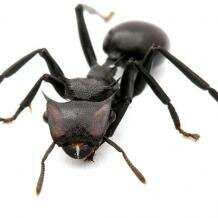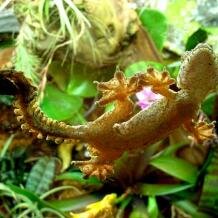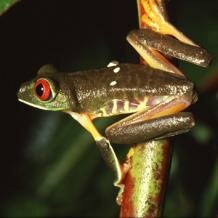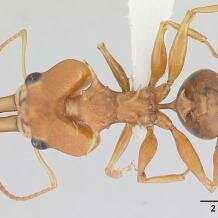Topic: Gliding lizards, frogs and ants
Tree-dwelling (‘arboreal’) ants capable of controlled gliding do so when dislodged or threatened by predation. Gliding species include members of three disparate families: Myrmicinae, Pseudomyrmecinae and Formicinae.

Gliding geckos, lacertids and frogs
 1. Inter-digital membranes
1. Inter-digital membranes
One of the main adaptations for gliding in certain tree-dwelling (‘arboreal’) lizards is the presence of skin membranes (‘patagia’) on various parts of the body, that open out passively due to air pressure as the animal falls, generating a degree of lift. In addition, the lizard body is often highly flattened and stereotyped movements may be employed to ensure an efficient, directed and stable glide. Well-developed patagial membranes between fingers and toes (technically termed ‘inter-digital webbing’) are a prime feature of gliding geckos (e.g. the two species of Cosymbotus and six species of Ptychozoon from South-East Asia and Indo-Australia) and the distantly related West African lacertid, Holaspis guentheri.  All these lizards glide on inter-digital membranes, critically augmented with small lateral fringes or flaps of skin on the digits, limbs, trunk and tail. These lateral skin flaps (‘patagia’) enhance aerofoil properties when gliding from tree to tree, as well as functioning in camouflage when the animal is motionless.
All these lizards glide on inter-digital membranes, critically augmented with small lateral fringes or flaps of skin on the digits, limbs, trunk and tail. These lateral skin flaps (‘patagia’) enhance aerofoil properties when gliding from tree to tree, as well as functioning in camouflage when the animal is motionless.
Convergence on webbed digits and stereotyped gliding postures has occurred not only in lizards (geckos and lacertids), but also in (i) two independent lineages of ‘flying’ frogs (New World ‘Hylidae’ e.g. Hyla miliaria and Old World ‘Rhacophoridae’ e.g. Rhacophorus nigropalmatus, Polypedates dennysi) from tropical and neotropical forest environments, and (ii) colugos which are extremely specialised gliding mammals.  The two known species of colugo (Cynocephalus volans and Galeopterus varieagatus) inhabit South-East Asian rainforests, and may be the closest living relatives of primates. Frogs use gliding to reach mating sites on the rainforest floor and to escape from predators, whereas geckos (Ptychozoon), lacertids (Holaspis) and colugos primarily glide between trees in search of food, mates and to deter conspecifics who trespass into their territory and only secondarily to find safety from predation.
The two known species of colugo (Cynocephalus volans and Galeopterus varieagatus) inhabit South-East Asian rainforests, and may be the closest living relatives of primates. Frogs use gliding to reach mating sites on the rainforest floor and to escape from predators, whereas geckos (Ptychozoon), lacertids (Holaspis) and colugos primarily glide between trees in search of food, mates and to deter conspecifics who trespass into their territory and only secondarily to find safety from predation.
2. Lateral body flaps
Augmenting inter-digital webbing, gliding geckos and lacertids have small lateral fringes or flaps on the digits, limbs, trunk and tail; these additional patagia provide greater aerofoil properties when gliding from tree to tree, as well as enhancing camouflage (‘crypsis’) when the animal is motionless. Small gliding membranes on the limbs and body trunk are features that also characterise both independent lineages of flying frogs (e.g. Hyla, Rhacophorus) in the tropics.
The lateral body extensions of gliding lizards and frogs are slightly reminiscent of the more extensive lateral ‘wing’ patagium found in certain extinct reptiles (e.g. Coelurosauravus jaekeli, Xianglong zhaoi, Sharovipteryx mirabilis) and gliding mammals such as flying squirrels, phalangers and colugos.
Gliding ants
Among insects, arguably the most remarkable instance of convergent adaptation to gliding is found in a diversity of specialised ants which inhabit tropical forests.  Tree-dwelling (‘arboreal’) ants capable of controlled gliding do so when dislodged from a tree trunk or threatened by predation. Gliding species include members of three separate families: Myrmicinae (e.g. Cephalotus atratus, Daceton armigerum, Procryptocerus convergens), Pseudomyrmecinae (e.g. Pseudomyrmex elongatus) and Formicinae (a single species, Camponotus canescens). All of these ants possess lateral flaps, or flanges, on their bodies, and in the Myrmicinae and Pseudomyrmicini – which glide abdomen first – have a moveable post-petiole region, enabling accurate steering during aerial descent. They are further adapted to gliding by having a dorso-ventrally flattened body for an improved lift:drag ratio and good vision for locating landing sites on approaching tree trunks. This suite of morphological adaptations illustrates convergence on a shared solution to selection pressure for gliding ability, having arisen in three distinct ant families and in sub-sets of species within certain genera (e.g. there are both gliding and non-gliding species of Daceton, Pseudomyrmex and Camponotus).
Tree-dwelling (‘arboreal’) ants capable of controlled gliding do so when dislodged from a tree trunk or threatened by predation. Gliding species include members of three separate families: Myrmicinae (e.g. Cephalotus atratus, Daceton armigerum, Procryptocerus convergens), Pseudomyrmecinae (e.g. Pseudomyrmex elongatus) and Formicinae (a single species, Camponotus canescens). All of these ants possess lateral flaps, or flanges, on their bodies, and in the Myrmicinae and Pseudomyrmicini – which glide abdomen first – have a moveable post-petiole region, enabling accurate steering during aerial descent. They are further adapted to gliding by having a dorso-ventrally flattened body for an improved lift:drag ratio and good vision for locating landing sites on approaching tree trunks. This suite of morphological adaptations illustrates convergence on a shared solution to selection pressure for gliding ability, having arisen in three distinct ant families and in sub-sets of species within certain genera (e.g. there are both gliding and non-gliding species of Daceton, Pseudomyrmex and Camponotus).
Flying squid
 As a final example of possible convergent recruitment of lateral body flaps to aid gliding, there is a (somewhat tentative) connection to the 15 or so known species of ‘flying’ squid. These marine creatures are cephalopod molluscs (i.e. invertebrates) of the family Ommatostrephidae, and include species such as the Humboldt squid Dosidicus gigas, Japanese flying squid Todarodes pacificus and Neon flying squid Ommastrephes bartramii. Aerial locomotion in squid depends mainly on powerful jet propulsion as water is forced out of a modified siphon, but well-developed lateral fins are proposed to play a role in stabilising and directing its gliding flight, reminiscent of the hypothesised role of lateral body fringes in ants, lizards and frogs in conferring extra lift and stability during controlled descent.
As a final example of possible convergent recruitment of lateral body flaps to aid gliding, there is a (somewhat tentative) connection to the 15 or so known species of ‘flying’ squid. These marine creatures are cephalopod molluscs (i.e. invertebrates) of the family Ommatostrephidae, and include species such as the Humboldt squid Dosidicus gigas, Japanese flying squid Todarodes pacificus and Neon flying squid Ommastrephes bartramii. Aerial locomotion in squid depends mainly on powerful jet propulsion as water is forced out of a modified siphon, but well-developed lateral fins are proposed to play a role in stabilising and directing its gliding flight, reminiscent of the hypothesised role of lateral body fringes in ants, lizards and frogs in conferring extra lift and stability during controlled descent.
—
From the above examples we can see that lateral body flaps have evolved in combination with a dorso-ventrally flattened body to promote gliding in several animal groups: ants, lizards, frogs and to an extent even so-called ‘flying’ squid all use such adaptations. These lateral flaps of chitinous exoskeleton (e.g. in ants) or keratinous outer skin layers (e.g. in lizards) are illuminating examples of convergent evolution, present in diverse animals as a shared solution to the need to general additional ‘lift’ forces during aerial locomotion.
Cite this web page
Map of Life - "Gliding lizards, frogs and ants"
https://mapoflife.org/topics/topic_347_gliding-lizards-frogs-and-ants/
July 31, 2017

